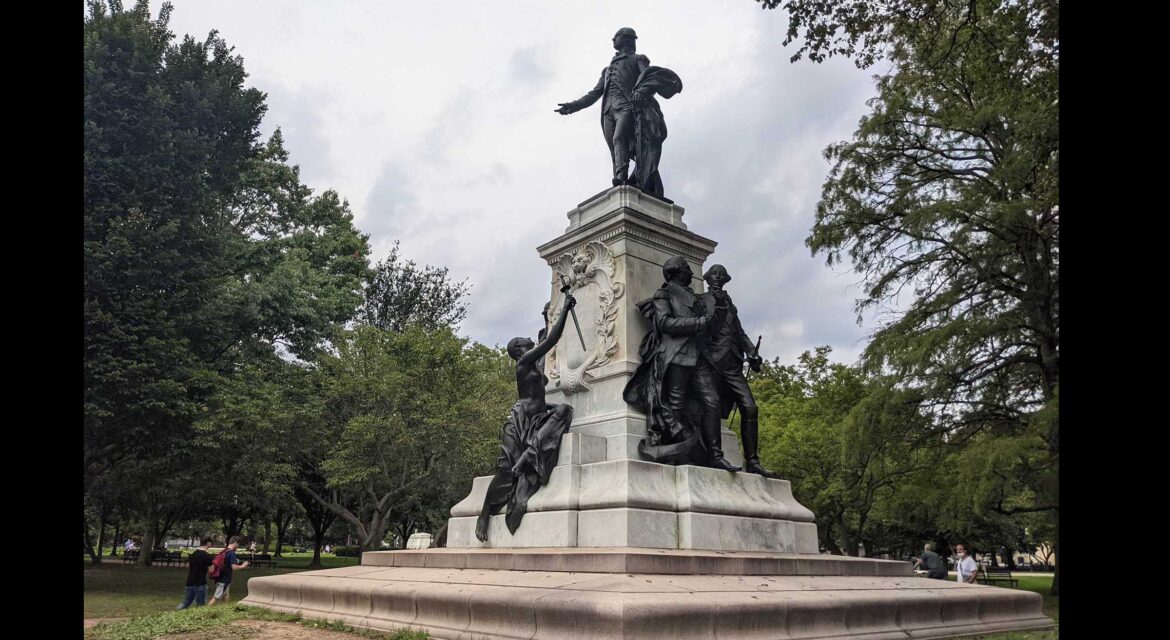 Originally part of the pleasure grounds for the White House, Lafayette Square has instead become an essential part of the community for residents and visitors in Washington D.C. Described as a green interval amidst the urban landscape of downtown D.C., it features some of the best views of the White House and has become a hub of activity that allows people to do anything from relax to take part in a protest or event. It highlights the many ways such landmarks can become part of and define a community.
Originally part of the pleasure grounds for the White House, Lafayette Square has instead become an essential part of the community for residents and visitors in Washington D.C. Described as a green interval amidst the urban landscape of downtown D.C., it features some of the best views of the White House and has become a hub of activity that allows people to do anything from relax to take part in a protest or event. It highlights the many ways such landmarks can become part of and define a community.

A Place for the Community to Relax and Gather
 Originally called “President’s Park,” the space had been used as a racetrack, a graveyard, a zoo, a slave market and an encampment for soldiers. In 1824 the first walks were laid out and it was officially renamed in honor of the Marquis de Lafayette, the Frenchman and military officer who fought in the American Revolutionary War. The current layout of the park was defined in the 1930s, not long after all of the five statues that have come to define it were installed.
Originally called “President’s Park,” the space had been used as a racetrack, a graveyard, a zoo, a slave market and an encampment for soldiers. In 1824 the first walks were laid out and it was officially renamed in honor of the Marquis de Lafayette, the Frenchman and military officer who fought in the American Revolutionary War. The current layout of the park was defined in the 1930s, not long after all of the five statues that have come to define it were installed.
The middle of the square contains an equestrian statue of President Andrew Jackson that was erected in 1853. Wide, brick paths radiating from it have defined the look and feel of the entire space. It is surrounded by statues of foreign Revolutionary War heroes that were installed between 1891 and 1910, the largest of which depicts the Marquis de Lafayette. The other three corners contain statues depicting the comte de Rochambeau of France, Tadeusz Kościuszko, of Poland and the Baron von Stueben, of Prussia. All of them honor foreign figures who fought in the American Revolution.
Although the buildings around Lafayette Square were once home to Washington’s elite, the last private residence was eliminated in 1954. New executive office and court buildings were constructed at this time, but an active effort was made to preserve the architectural character of the neighborhood that was centralized in Lafayette Square. This transition also enabled the space to be actively embraced by the community as a place to gather and relax but also exercise their right of free speech. It is home to the longest running anti-nuclear peace vigil in US history and it continues to be the site of many political protests and celebrations.
The square and the surrounding structures were designated the Lafayette Square Historic District in 1970, further showcasing how the square connects the past with the future of Washington D.C. for the benefit of the community in the present.
Notable Pieces of History
 Lafayette Square has long served as a place for political and social demonstrations. That it has been able to do so in space that could have otherwise been a private park or become a governmental administration building highlights how such spaces can become a hub of the community activity, partly in thanks to the notable pieces of history that they can both contain and preserve.
Lafayette Square has long served as a place for political and social demonstrations. That it has been able to do so in space that could have otherwise been a private park or become a governmental administration building highlights how such spaces can become a hub of the community activity, partly in thanks to the notable pieces of history that they can both contain and preserve.


